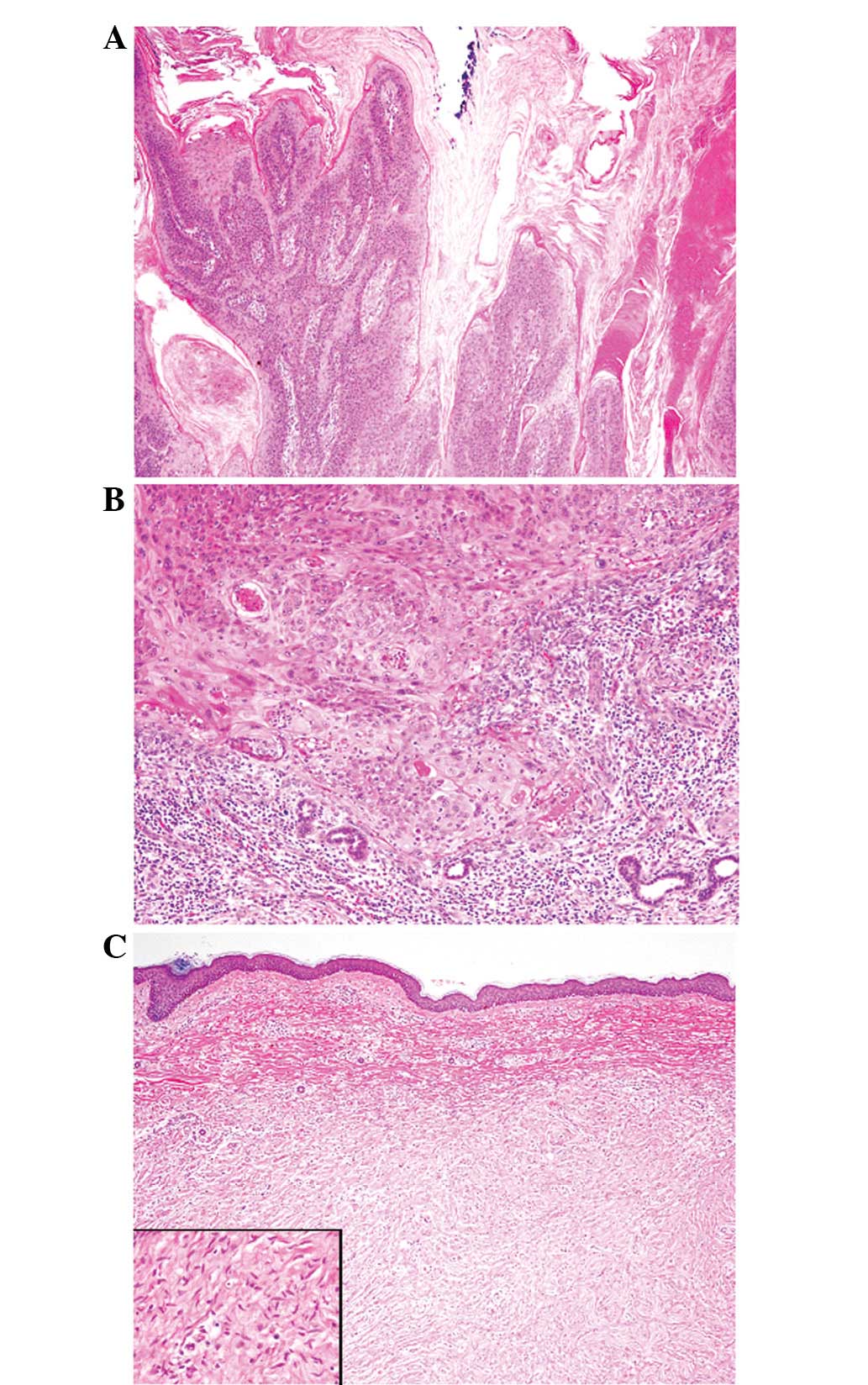Cutaneous squamous cell carcinoma in a patient with neurofibromatosis type 1: A case report
- Authors:
- Mitsuaki Ishida
- Hidetoshi Okabe
View Affiliations
Affiliations: Department of Clinical Laboratory Medicine and Division of Diagnostic Pathology, Shiga University of Medical Science, Otsu, Shiga, Japan
- Published online on: July 25, 2013 https://doi.org/10.3892/ol.2013.1490
-
Pages:
878-880
Metrics: Total
Views: 0 (Spandidos Publications: | PMC Statistics: )
Metrics: Total PDF Downloads: 0 (Spandidos Publications: | PMC Statistics: )
This article is mentioned in:
Abstract
Neurofibromatosis type 1 (NF1) is an autosomal dominant inherited disease that is characterized by the presence of multiple neurofibromas, café-au-lait spots and iris hamartomas. It is well established that the incidence of tumors in patients with NF1 is high compared with the normal population and that the majority of the tumors are non-epithelial neoplasms, including neurofibromas, malignant peripheral nerve sheath tumors, gliomas and leukemia. Studies have suggested that patients with NF1 also have a significantly higher risk of certain types of carcinomas. However, the occurrence of cutaneous squamous cell carcinoma (SCC) in a patient with NF1 is extremely rare. The present study describes the second documented case of a cutaneous SCC adjacent to a neurofibroma of the forehead with histopathological analyses in a patient with NF1. An 80-year-old female with NF1 presented with a rapidly growing skin tumor of the forehead. Histopathological study of the resected forehead tumor demonstrated that there were two tumorous lesions. One was an invasive SCC and the other was a neurofibroma. The lesions were adjacent, but no continuity was present. NF1 is caused by inactivating mutations in the NF1 gene and loss of heterozygosity of this gene has been reported in neurofibromas, malignant peripheral nerve sheath tumors, gliomas and pheochromocytomas in patients with NF1. However, the genetic mechanism of carcinoma development in patients with NF1 is not well understood. Studies have suggested the role of the NF1 and/or the BRCA gene in the occurrence of breast cancer. Additional studies are required to elucidate these mechanisms.
View References
|
1
|
Brems H, Beert E, de Ravel T and Legius E:
Mechanisms in the pathogenesis of malignant tumours in
neurofibromatosis type 1. Lancet Oncol. 10:508–515. 2009.
View Article : Google Scholar : PubMed/NCBI
|
|
2
|
Seminog OO and Goldacre MJ: Risk of benign
tumours of nervous system, and of malignant neoplasms, in people
with neurofibromatosis: population-based record-linkage study. Br J
Cancer. 108:193–198. 2013. View Article : Google Scholar : PubMed/NCBI
|
|
3
|
Zöller ME, Rembeck B, Odén A, Samuelsson M
and Angervall L: Malignant and benign tumors in patients with
neurofibromatosis type 1 in a defined Swedish population. Cancer.
79:2125–2131. 1997.PubMed/NCBI
|
|
4
|
Salemis NS, Nakos G, Sambaziotis D and
Gourgiotis S: Breast cancer associated with type 1
neurofibromatosis. Breast Cancer. 17:306–309. 2010. View Article : Google Scholar : PubMed/NCBI
|
|
5
|
Sharif S, Moran A, Houson SM, et al: Women
with neurofibromatosis 1 are at a moderately increased risk of
developing breast cancer and should be considered for early
screening. J Med Genet. 44:481–484. 2007. View Article : Google Scholar : PubMed/NCBI
|
|
6
|
Friedrich RE, Al-Dam A and Hagel C:
Squamous cell carcinoma of the sole of the foot in
neurofibromatosis type 1. Anticancer Res. 32:2165–2168.
2012.PubMed/NCBI
|
|
7
|
Seizinger BR: NF1: a prevalent cause of
tumorigenesis in human cancers? Nat Genet. 3:97–99. 1993.
View Article : Google Scholar : PubMed/NCBI
|
|
8
|
Laycock-van Spyk S, Thomas N, Cooper DN
and Upadhyaya M: Neurofibromatosis type 1-associtated tumours:
their somatic mutational spectrum and pathogenesis. Human Genomics.
5:623–690. 2011.PubMed/NCBI
|
|
9
|
Garcia-Linares C, Fernández-Rodriguez J,
Terribas E, et al: Dissecting loss of heterozygosity (LOH) in
neurofibromatosis type 1-associated neurofibromas: Importance of
copy neutral LOH. Hum Mutat. 32:78–90. 2011. View Article : Google Scholar : PubMed/NCBI
|
|
10
|
Upadhyaya M, Kluwe L, Spurlock G, et al:
Germline and somatic NF1 gene mutation spectrum in NF1-associated
malignant peripheral nerve sheath tumors (MPNSTs). Hum Mutat.
29:74–82. 2008. View Article : Google Scholar : PubMed/NCBI
|
|
11
|
Gutmann DH, Donahoe J, Brown T, James CD
and Perry A: Loss of neurofibromatosis 1 (NF1) gene expression in
NF1-associated pilocytic astrocytomas. Neuropathol Appl Neurobiol.
26:361–367. 2000. View Article : Google Scholar : PubMed/NCBI
|
|
12
|
Bausch B, Borozdin W, Mautner VF, et al;
European-American Phaeochromocytoma Registry Study Group. Germline
NF1 mutational spectra and loss-of-heterozygosity analyses in
patients with pheochromocytoma and neurofibromatosis type 1. J Clin
Endocrinol Metab. 92:2784–2792. 2007. View Article : Google Scholar : PubMed/NCBI
|
|
13
|
Güran S and Safali M: A case of
neurofibromatosis and breast cancer: loss of heterozygosity of NF1
in breast cancer. Cancer Genet Cytogenet. 156:86–88.
2005.PubMed/NCBI
|
|
14
|
Ceccaroni M, Genuardi M, Legge F, et al:
BRCA1-related malignancies in a family presenting with von
Recklinghausen’s disease. Gynecol Oncol. 86:375–378.
2002.PubMed/NCBI
|











